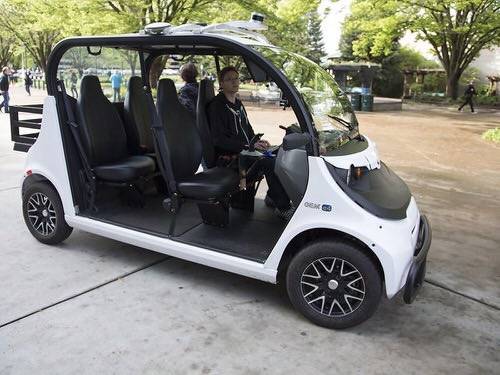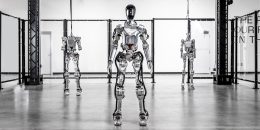While autonomous carmakers are focusing on mass-market consumer vehicles they expect to deploy in the coming decades, there are startups developing smaller scale alternatives that could be ready much sooner.
Startup Varden Labs is developing a line of autonomous shuttles it expects to launch in 2017. The company is currently testing these shuttles – designed for large outdoor facilities like amusement parks and airports – on a handful of Californian college campuses. By avoiding public roads, they hope to accelerate the shuttles’ development cycle without compromising safety.
“Alvin,” the Varden Labs shuttle currently on tour, looks more like a four-seated golf cart than a car. According to the company’s co-founder, Alex Rodrigues, by 2017 Alvin will be upgraded to be fully ADA-compliant and able to seat 15 passengers. He also intends for these shuttles to be available on demand rather than following fixed bus routes. All of these features will require extensive research, and experts think that universities are the place to do it.
Why college campus driverless shuttles
What makes college campuses so popular? The most obvious advantage is that sprawling private spaces provide an important transitional environment between highly-controlled testing facilities and the chaos of the open road. Campus drives are bustling enough to test real-world situations without the complicated layout of most city streets. They’re also pedestrian-friendly, forcing both driverless and conventional vehicles to maintain a slower, safer speed.
Campus transit agencies also tend to enforce more relaxed regulations while also being more open to new ideas. Former transit official-turned-consultant Bob Bourne explains why: “Most cities […] don’t want to take too much risk, whereas in the campus environment it’s okay to take a risk and fail. In city government, you’re punished or crucified.”
Bourne also asserts that these small shuttles are only the first step towards autonomous vehicles replacing conventional campus buses. He believes that before these shuttles can compete with conventional vehicles, they’ll need to match them in capacity. Even at 15 seats, Varden Labs’s shuttles would only seat a quarter of the passengers that the typical city bus can.
Replacing bus drivers entirely also seems unlikely. Their other duties, like assisting disabled passengers and breaking up fights, won’t be automated any time soon.










